Explore the latest insights from top science journals in the Muser Press daily roundup (October 26, 2025), featuring impactful research on climate change challenges.
In brief:
Patagonia’s ice sheet danced to a different beat
Patagonia is an impressively diverse region with a wide variety of landscapes. Expansive forests, open grasslands, arid deserts and imposing mountain ranges characterize the region. But it was not always so diverse, and even today the relics of a completely different landscape can be found: the Patagonian ice fields. In the western part of the region, compact glacier areas stretch for hundreds of kilometers along the Andes in Chile and Argentina. The northern and southern Patagonian ice fields are remnants of a much larger ice cover that reached its maximum extent around 35,000 years ago. At that time the central Andes Mountain chain was covered with ice between 38 and 55 degrees southern latitude.
“The aim of our study was to investigate the spatial-temporal history of the Patagonian ice sheet during the entire last glacial cycle – from around 120,000 years ago until today – and thus to gain a better understanding of the causes for the temporal sequences and dynamics of the advances and retreats of the glaciers,” explains Dr. Andrés Castillo-Llarena, first author of the study and Earth-System modeler at MARUM – Center for Marine Environmental Sciences, and the Geosciences Department of the University of Bremen. A primary focus of the international team was the role of climate variability on a millennial timescale as a driving mechanism for changes in the Patagonian ice sheet.
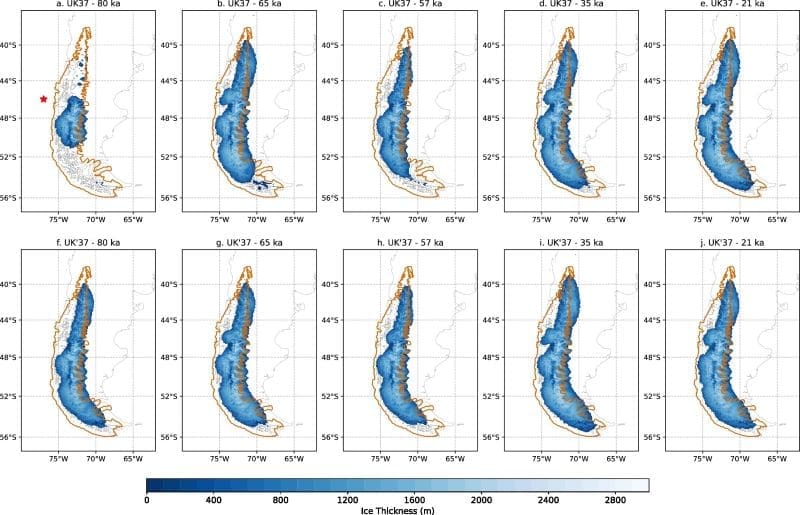
The last ice age had an impact on environmental conditions and landscapes around the world. North America, northern Europe and Patagonia in particular were heavily covered by gigantic ice sheets that subsequently disappeared after the ice age. Because the growth and shrinking of the ice masses was largely controlled by fluctuations of temperature and precipitation, the ice sheets of the past provide important information about past climate changes. The present paleoclimatic findings from Patagonia and New Zealand indicate that the maximum glacier expansion in the middle latitudes of the southern hemisphere occurred almost simultaneously, but was not synchronous with the glacial history of the northern hemisphere.
In order to study this more closely, Castillo-Llarena’s team carried out computer simulations. Their results indicate that the ice cover of the Patagonian ice sheet underwent periods of expansion and contraction rather than having a uniform ice-age history, which is contrary to earlier assumptions that were based on geological reconstructions. They further show that the Patagonian ice sheet underwent two main periods of glacial advance during the last ice-age cycle: At the beginning of marine isotope stage (MIS) 4 around 71,000 years ago and at the end of MIS 3 around 35,000 years ago. Between these there was a temporary shrinking of the ice sheet at about 60,000 years ago.
The team of researchers was able to identify the driving force for the long-term fluctuations as the combination of changes in the duration of summer seasons with the intensity of summer solar radiation, which is known as “integrated summer energy”. This fluctuates with changes in the Earth’s tilt on a time scale of around 40,000 years. “We suspect that the integrated summer energy modulated not only the behavior of the Patagonian ice sheet, but also that of the other ice masses throughout the mid-latitudes of the southern hemisphere,” said Castillo-Llarena.
In addition, the team discovered that, superimposed upon the long-term fluctuations, there were short-term variations in the Patagonian ice sheet at millennial time scales that can be linked to abrupt climate changes in the northern hemisphere.
“These findings are of particular significance because there are relatively few data on past climate fluctuations from the southern hemisphere. For a better understanding of future climate change, however, it is important to understand how the northern and southern hemispheres interact with one another,” explains MARUM scientist Dr. Matthias Prange, a co-author of the study.
The research was carried out as part of the Cluster of Excellence “The Ocean Floor – Earth’s Uncharted Interface,” which is based at MARUM.
Participating institutes:
- MARUM – Center for Marine Environmental Sciences, University of Bremen
- Department of Geosciences, University of Breman
- The Center for Advanced Studies in Arid Zones (CEAZA), La Serena, Chile
- Department of Geography, Norwegian University of Science and Technology (NTNU), Trondheim, Norway
- University of La Serena, Faculty of Engineering, La Serena, Chile
Journal Reference:
Castillo-Llarena, A., Prange, M. & Rogozhina, I., ‘Orbital and millennial-scale forcing of the Patagonian Ice Sheet throughout the Last Glacial Cycle’, Nature Communications 16, 8776 (2025). DOI: 10.1038/s41467-025-64614-5
Article Source:
Press Release/Material by MARUM – Center for Marine Environmental Sciences, University of Bremen
More milk, less methane in mixed pastures?
Allowing dairy cows to graze on fresh grass in open pastures for a significant proportion of the year seems more natural and sustainable. And there are proven advantages for the environment: stable grasslands promote biodiversity, protect the soil, and support carbon storage. However, farms face challenges as they are heavily dependent on the weather and the time of the year. Farming is more productive when the pastures have a wide variety of different grasses, herbs and legumes, such as clover and chicory.
A research team at the University of Göttingen has analysed this strategy using a meta-analysis of a number of studies. The analysis showed that the diversity of pastureland has no effect on milk production or on emissions of the greenhouse gas methane, which cows emit mainly when they burp. However, a higher proportion of legumes can promote milk production. The results were published in the journal Food and Energy Security.
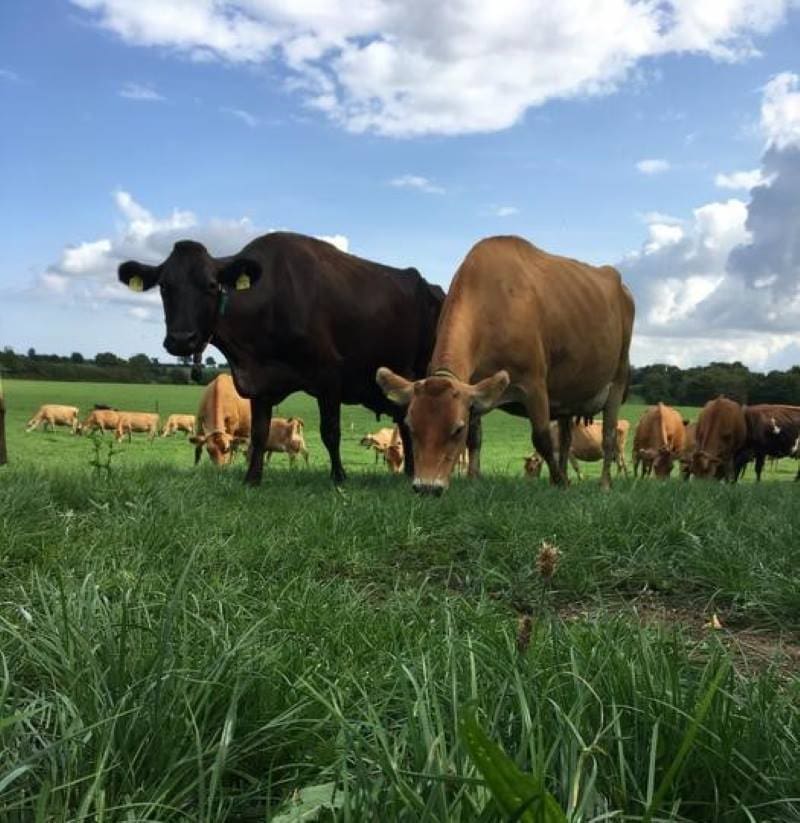
In this meta-analysis of 16 studies, the researchers compared grasslands with diverse vegetation and less species-rich pastureland and considered the effects on milk production and methane emissions, as well as the nutritional value of the feed. The fact that no clear correlations could be identified may be due to methodological reasons, as lead author Dr Martin Komainda at Göttingen University’s Institute of Grassland Science explains: “Ten of the studies lasted ten days or less. However, the productivity and nutritional value of grassland areas fluctuate within seasons and between years. To better account for this, more year-round and multi-year studies are needed.”
Plant species that could affect methane emissions were also rarely found in the pastures studied.
However, the study does reveal one trend: the more legumes growing in the pasture, the higher the cows’ milk yield. The species-rich pastureland did not have significantly higher proportions of these plants than the less diverse reference grasslands but the researchers emphasise that biodiversity in pastureland is worthwhile none-the-less: “Farms should consider the benefits of diverse grassland areas in terms of overall productivity and benefits to the ecosystem, rather than expecting immediate improvements in milk production or methane reduction.”
***
The study was funded by the Federal Ministry of Food, Agriculture and Home Affairs, Federal Republic of Germany.
Journal Reference:
Komainda, M., F. Riesch, and J. Isselstein, ‘Boosting Grassland Output and Lowering Methane Emission by Grazing Dairy Cows on Diverse Pastures?’, Food and Energy Security 14, 4: e70113 (2025). DOI: 10.1002/fes3.70113
Article Source:
Press Release/Material by University of Göttingen
New study documents functional extinction of two critically endangered coral species following record heatwave in Florida
A new research paper published in Science reports the functional extinction of Acropora corals from Florida’s Coral Reef. Scientists documented catastrophic mortality of these critically endangered corals following a record-setting marine heatwave in 2023 that marked the ninth mass bleaching event for the region. Both Acropora coral species – staghorn (Acropora cervicornis) and elkhorn (Acropora palmata) – are important reef-builders in Florida and the Caribbean and have been a major focus of recent coral restoration efforts.
Led by the National Oceanic and Atmospheric Administration’s Coral Reef Watch and Chicago’s Shedd Aquarium, the study involved 47 authors representing 22 institutions that contributed data detailing the coral die-off. While some individual elkhorn and staghorn corals remain, their numbers are now so low that they can no longer fulfill their vital roles in the ecosystem – providing habitat for marine life and helping protect coastlines. This collapse of ecological function marks what scientists call a functional extinction, a stage that often precedes global extinction or the complete disappearance of species.
While most other coral species in Florida did not suffer losses as extreme as the more heat-sensitive Acropora, the loss of these species deals a devastating blow to the ecosystem and stands as a stark warning for the future of coral reefs worldwide.
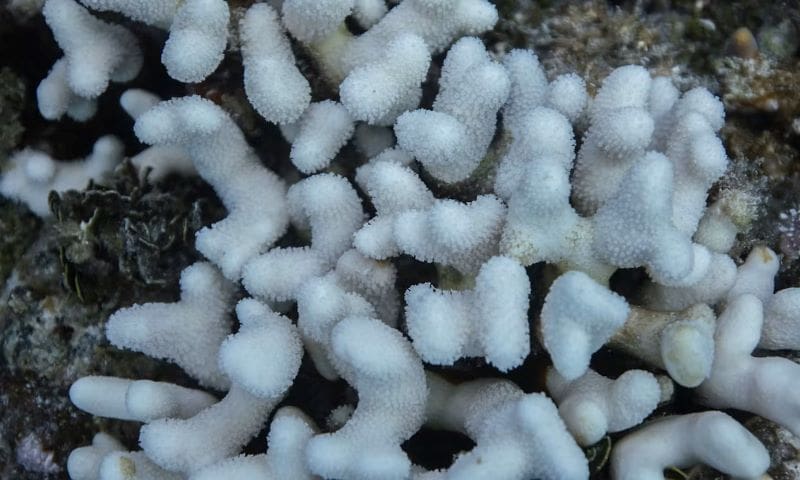
“We’re running out of time,” said Dr. Ross Cunning, research biologist at Shedd Aquarium and co–first author of the study. “Extreme heatwaves are increasing in frequency and severity due to climate change, and without immediate, ambitious actions to slow ocean warming and boost coral resilience, we risk the extinction of even more corals from reefs in Florida and around the world.”
The study documents that the temperatures reached during the 2023 heatwave were the highest ever recorded on Florida’s Coral Reef in over 150 years, and that the heat stress persisted for 2–3 months. Heat exposure levels were 2.2 to 4 times greater than in any previous year on record.
As the heatwave and mass bleaching event unfolded, the team of researchers conducted diver surveys to track more than 52,000 colonies of staghorn and elkhorn coral across 391 sites. In the Florida Keys and Dry Tortugas (almost 70 miles west of Key West), mortality rates reached a staggering 98–100%. Mortality rates were lower offshore in southeast Florida, at around 38%, reflecting cooler temperatures in the region.
These two species of coral were already in decline due to decades of disease, poor water quality, previous bleaching events and other human-driven stressors, but the 2023 marine heatwave accelerated the near-total collapse of staghorn and elkhorn corals on the reefs in this region. The population is unlikely to rebound without conservation interventions because of low numbers, continued warming, and additional stressors.
What Happens Next
Scientists have already established living repositories to safeguard remaining Acropora in aquarium facilities on land and in offshore coral nurseries and have rescued more of the survivors of the 2023 heatwave to bolster these collections. Under expert care, corals in these “gene banks” can continue to grow, supporting further research and restoration efforts for the species. Yet, the authors caution that the success of restoration will ultimately depend on the return time and severity of future bleaching events.
To secure a future for these species, restoration efforts must also incorporate new, adaptive interventions. Introducing resilient genetic diversity from outside Florida or manipulating the types of symbiotic algae that help corals tolerate heat may be the only means to maintain any Acropora populations in Florida.
Ultimately, the study underscores that ocean warming from climate change is now surpassing the thermal limits of entire populations of corals. Alongside bold, science-based actions to enhance coral resilience, urgent global action to slow climate change is essential to prevent the collapse of these critical reef ecosystems.
Journal Reference:
Derek P. Manzello, Ross Cunning et al., ‘Heat-driven functional extinction of Caribbean Acropora corals from Florida’s Coral Reef’, Science 390, 6771, pp. 361-366 (2025). DOI: 10.1126/science.adx7825
Article Source:
Press Release/Material by Shedd Aquarium
Researchers warn of the urgent need to include the cumulative effects of extreme climate events in penguin conservation
A new international analysis now published in Global Change Biology warns that penguin survival hinges on a shift in how science and conservation policy approach climate change: rather than examining extreme events in isolation, it is their cumulative effects that must be assessed. Applied for the first time in a quantitative way across habitats of all 18 penguin species in the Southern Hemisphere, this perspective provides a crucial tool to anticipate risks and design more effective conservation policies.
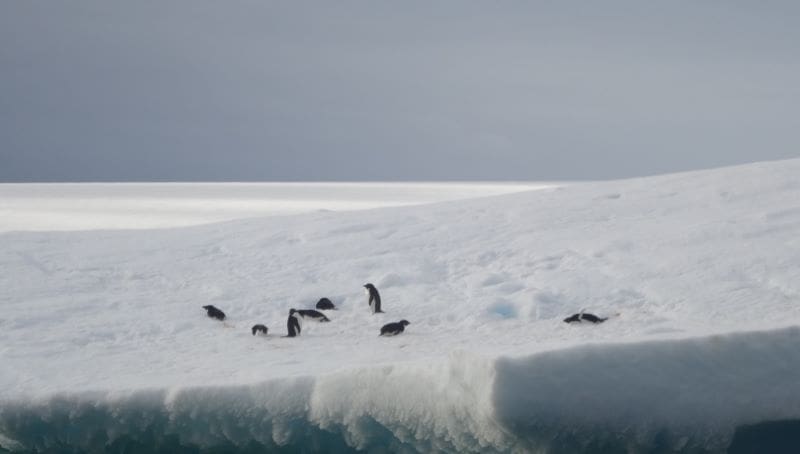
The study, led by the Institut de Ciències del Mar (ICM-CSIC) in collaboration with the Laboratoire LOCEAN-IPSL (Sorbonne Université) and Phillip Island Nature Parks, identifies which penguins are the most at risk from the growing accumulation of extreme climate events. According to the authors, the conclusions extend beyond the protection of these iconic seabirds: they identified regions particularly affected by the combined impacts of marine heatwaves, extreme winds, heavy rainfall, and terrestrial heatwaves, where these extreme events could reshape biodiversity and the ecosystem services provided by the oceans in the coming decades.
“Our findings reveal that extreme climate events are unevenly distributed across both land and sea in the Southern Hemisphere, pinpointing the areas where penguins are most at risk” said Camila Artana (LOCEAN-IPSL). “This work also lays the groundwork for assessing how other Southern Hemisphere species may be vulnerable to climate change.”
By analysing three decades of climate data, the researchers found that African, Snares, Emperor, Adélie, and Galápagos penguins are exposed to the greatest cumulative risks. Looking ahead, the whole penguin community are expected to face even greater intensity, duration, and frequency of extreme events in the coming decades.
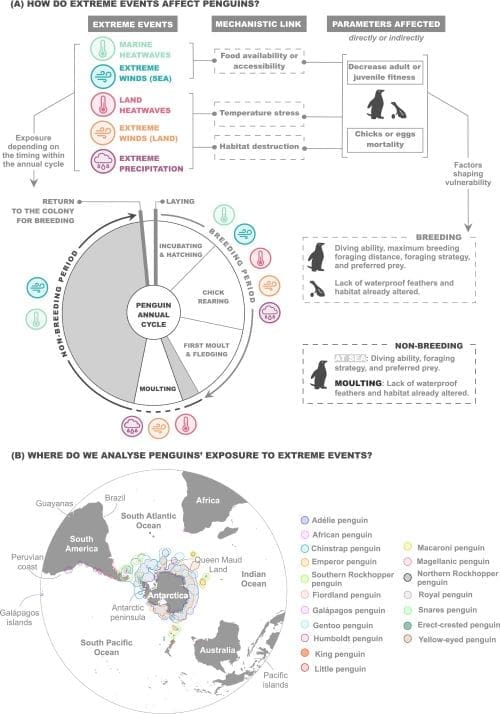
“Penguin habitats are not just impacted by isolated extreme events, but by their cumulative effects across both land and ocean environments,” explained Miriam Gimeno (ICM-CSIC), PhD student who led this work. “Evidence already suggests that these pressures could reduce reproductive success, foraging efficiency, and resilience.”
The researchers propose a three-step framework to reduce ecosystem vulnerability that could be applied to other species and regions worldwide. The first step is to identify priority hotspots where exposure to multiple extreme events is already high or rapidly increasing. The second is to factor in additional local stressors, such as fisheries, coastal development, or tourism, which can exacerbate climate impacts. Finally, the third step calls for adaptive management measures based on continuous monitoring, ensuring that conservation strategies remain flexible and responsive as new data and projections emerge.
Among the management actions recommended are stronger environmental protections in Antarctica, fisheries regulations to mitigate the potential impact of extreme events at sea, and restoration of breeding habitats to buffer the effects of land-based extreme events.
“By identifying the species and regions most at risk, we provide actionable insights for conservation planning and policy implementation, contributing to the goal of the IUCN Penguin Specialist Group to have Wild Penguins in perpetuity,” said Andre Chiaradia (Phillip Island Nature Parks). “Proactive, spatially informed management is essential to safeguard penguin populations in the face of escalating climate extremes.”
The study sends a clear message: penguins and their ecosystems cannot wait for incremental solutions. By revealing the hotspots and species most at risk from cumulative extreme climate events, the research provides a blueprint for urgent, targeted conservation action. Protecting penguins today means protecting the future of oceans and coastlines worldwide. The time to act is now.
Journal Reference:
Gimeno, M., F. Ramírez, M. Coll, A. Chiaradia, and C. Artana, ‘Cumulative Extreme Events Threaten Penguin Habitats Across the Southern Hemisphere’, Global Change Biology 31, 10: e70562 (2025). DOI: 10.1111/gcb.70562
Article Source:
Press Release/Material by Spanish National Research Council (CSIC)
Featured image credit: Gerd Altmann | Pixabay




